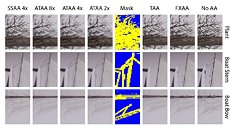Wednesday, August 1st 2018

NVIDIA Unveils Adaptive Temporal Anti-Aliasing with Ray-Tracing
NVIDIA published the first documentation of Adaptive Temporal Anti-Aliasing (ATAA), an evolution of TAA that incorporates real-time ray-tracing, or at least the low light-count method NVIDIA implemented with RTX. Its "adaptive" nature also lets it overcome many of the performance challenges users encounter with TAA in high framerate and rapidly changing 3D scenes, such as in games. Non-gaming scenes, such as those used by real-estate developers, don't face these challenges.
To developers, ATAA promises image quality comparable to 8x supersampling at a cost of under 33 ms frame delay. These numbers were derived on a TITAN V ("Volta"), using Unreal Engine 4. It could take a while for ATAA to make it to games, as developers will need a few months to learn the technique before implementing them in their ongoing or future projects. NVIDIA will introduce ATAA support through driver updates.
Sources:
NVIDIA (PDF), Videocardz
To developers, ATAA promises image quality comparable to 8x supersampling at a cost of under 33 ms frame delay. These numbers were derived on a TITAN V ("Volta"), using Unreal Engine 4. It could take a while for ATAA to make it to games, as developers will need a few months to learn the technique before implementing them in their ongoing or future projects. NVIDIA will introduce ATAA support through driver updates.

71 Comments on NVIDIA Unveils Adaptive Temporal Anti-Aliasing with Ray-Tracing
thanks, but no thanks.
Also, why even bother with this stuff. First it'll only be available from one vendor, probably supported by their latest flagship only, waiting 2 years for game engine teams to catch up and 2 more for actual games to even get it. Pointless. Post-process AA is the future imo. Just look at SMAA. It's doing great at smoothing edges without blurring details and hardly has any performance hit. Why not build on top of that and add it to the NVIDIA Control Panel so you can just force it on any game and call it a day. I don't want to wait 5 years for features to appear in 3 games and that's it. Instead we still only have garbage FXAA which works but there are far better options and they refuse to add them. I guess that ancient looking NV CP is to much of a hassle t work with...
Basically the same situation as with MSAA which was awesome as they made better versions of it till Deferred rendering became defacto. Then it basically became useless since it didn't work anywhere anymore. No one is investing in MSAA anymore, so why bother with these game specific proprietary edge smoothing algorithms? Just take SMAA and make it even better. It's proven tech that users can actually use NOW.
But nice try, selling a crippling AA that equals an SSAA level nobody ever really needs.
Ray tracing so far is a buzz word that brings us nothing substantial. Its not new. And its still crippling performance. So where's the progress?
And I disagree about SSAA levels "nobody ever really needs". I could easily spot AA differences to the point 2xMSAA didn't make any sense to me. The quality difference is there. But it depends on what you're playing. While playing Witcher, there's a lot of stuff you can stop and admire. While playing Fortnite, not so much.
And even the SSAA x4 comparison up there looks much better than any of the ATAA alternatives. In the end you're still tied to the physical pixels and that can only go two ways: blurry or sharp with aliasing.
AA doesn't have to be a choice between blurry and sharp. If done right it can alter just the right pixels without altering sharpness. But these methods are always more intensive, that why everyone is scrambling for alternatives.
Edit: Is there a typo in the article or did they choose to say it compares to 8X SSAA and then not provide a comparison image?
About the added delay, any form of post-processing adds delay, it's not like can look at 2-8 million pixels in zero time. Much less compute something about them. The 33ms is a meaningless number as long as we don't know what delay other AA techniques introduce.
I'm not saying that this new ATAA and RTX is bogus, it isn't. I'm sure they'll look friggin amazing. It's just that early adopters will see very little benefit compared to performance hit it will take.
They'll be "happy" to take the performance hit, so long as any AMD cards have a BIGGER performance hit.
BTW you have old info on gameworks, like most of red team supporters you like to complain more than you like to absorb information